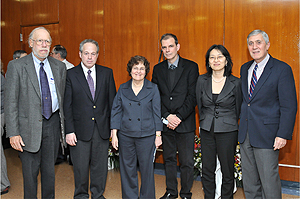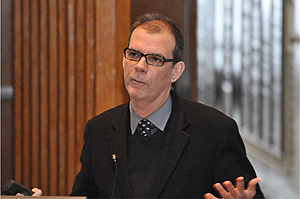

FULL STORY
Annual Lecture Prizes Research Excellence While Honoring a Legacy
On Tuesday, February 16, nearly 250 members of the Einstein community gathered in Robbins Auditorium for the fourth Marshall S. Horwitz Prize Lecture. Delivering this year’s lecture was Dr. Arturo Casadevall, professor and Leo and Julia Forchheimer Chair in Microbiology & Immunology, who received this year’s annual prize recognizing excellence in faculty research that was established to honor the memory of Dr. Horwitz, a much-beloved faculty member who was professor and chair of microbiology & immunology at the time of his death, in 2005.

Drs. Matthew Scharff, Richard Kitsis, Susan Horwitz,
Arturo Casadevall, Kami Kim, and Allen M. Spiegel During a brief introduction of the event, Dr. Richard Kitsis noted, “It has been five years since Marshall died.” He then related how Marshall was renowned for much more than his science. "He was a very accomplished electrician," he recalled fondly. "As a neighbor of mine in Larchmont, he couldn’t understand why there were vans for electricians and other repairmen at our home. He would show me how to do things so that I could do them myself."
Next, Dr. Kami Kim noted how Dr. Horwitz’ legacy continues scientifically, with his name appearing as co-author on as many as eight journal articles in recent years. “His students completed their projects, with support here at Einstein, and honored his memory and influence by including his name when they published their work.” The honor is particularly fitting, added Dr. Kim, since “no one took greater delight in students’ successes.”
In introducing the afternoon’s honoree, Dr. Matthew Scharff — both a previous winner of the Horwitz Prize and a mentor of Dr. Casadevall’s — said, “I think Marshall would be very pleased that Arturo is the recipient of this award… Arturo calls the work in his lab ‘reductionist science’ and is always thinking of other possibilities. He is always asking ‘why’ in addition to ‘how.’ And it’s a great pleasure to watch Arturo open up his mind and allow the rest of us to benefit from the thoughts he’s having.”
Before beginning his lecture, Dr. Casadevall recalled, “Marshall Horwitz and I were very close. For many, many years, I talked to him almost daily and I learned a lot from him, including the fact that you can learn a lot from a microbe.”
He also noted, “In looking at the questions of science, we leave ‘when’ to the archaeologists... We tend to focus on the ‘what’ and ‘how.’ The question ‘why’ is seldom dealt with by scientists.”
He continued, “We say, ‘if you want answers to why, ask a philosopher,’ but we forget that science grew out of philosophy. We do need to think about the ‘why’ question, and we can do so without going off the deep end.”
While the focus of Dr. Casadevall’s lecture was “Thoughts into the Origins of Microbial Virulence,” during the highlights that he offered from his research, he also demonstrated how the question ‘why’ has led him to interesting discoveries.
He began by discussing pathogens and their hosts and their symbiotic relationship. He then discussed the microbe most studied in his laboratory, Cryptococcus neoformans (CN). “The virulence factor for fungus is well-defined and initial infection in most people occurs during childhood,” he said. “But most of us have great innate resistance so that infection is common but disease is very rare, at least in healthy people. It is most virulent to those with compromised immune systems.”
Next, Dr. Casadevall discussed the relationship between CN and melanin that has led to a number of explorations in his lab, as well as collaborations with Einstein colleagues. Most notably, he shared the success that he and Dr. Ekaterina Dadachova have experienced in developing a potential treatment for melanoma, using radioimmunotherapy that targets melanin-based antibodies.
He also described their study of fungal melanin, motivated by the reported presence of melanotic fungi found around the reactors near Chernobyl. “We were able to demonstrate that melanin functions as an energy transduction molecule and that melanotic fungi were able to make their own food,” he noted.

Dr. Arturo Casadevall As his talk drew to its conclusion, Dr. Casadevall posed another ‘why’ question with regard to fungi: Of the 1.5 million fungal species, why are there so very few fungal pathogens for mammals? In discussing this question, he noted that fungal pathogens wreak havoc among amphibians, exemplified by its role in causing the recent extinction of a type of frog. He then discussed endothermy (body temperature) as a mechanism of protection, asserting that a mammal’s higher body temperature prevents susceptibility to the virulence of fungal pathogens.
He cited a rare instance, occurring in the past year, when many bats in United States were dying as a result of fungal pathogens. “The fungi attack when these mammals are hibernating and their body temperature drops below 37 degrees, which is the temperature at which fungi are able to grow.”
He added, “The hotter you are, the more efficient you are at evading fungal pathogens.” He then noted that some frogs were recently found to be protected from the pathogen at temperatures above 37 degrees. “Climate change may have relevance, and perhaps global warming could help save the frogs,” he noted.
“Or, perhaps new fungal pathogens will emerge with climate change that will be able to grow at 37 degrees. If that happens, we may see huge changes in fungal diseases.”
When it comes to exploring such questions, you can be sure that Dr. Casadevall will be on the case.
Posted on: Monday, April 12, 2010

Tablet Blog